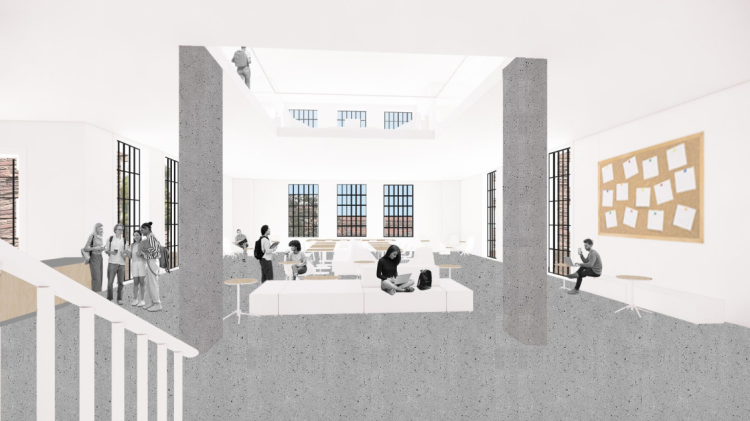The project team aims to make this iconic academic building an inclusive space, focused on student success and vibrant workspace
About half of first-year students take a course in the Hellems Arts and Sciences building, and by the time they graduate, about 85% of all undergraduates take at least one course there. On this campus, Hellems takes a leading role in academics, but lately it might seem withered in the spotlight.
That’s because the building was constructed in 1921, when the U.S. president was Warren G. Harding and baseball’s superstar was a 28-year-old Babe Ruth. Since then, a great deal is new, but the building itself remains largely vintage.
As the University of Colorado gears up for a major renovation of Hellems, officials are asking students, faculty and staff to share their ideas, photos and suggestions about how to make the new-and-improved Hellems an inclusive and welcoming space—a space focused on an invigorating student experience and a refreshed work and research environment for the arts and humanities.

At the top of the page: Hellems Arts and Sciences is seen with the Flatirons beyond. Above: Hellems Arts and Sciences, shown here in the 1930s, was the first building on campus built using the trademark Tuscan Vernacular style (A.A. Paddock Collection : University of Colorado, Boulder).
The 95,000-square-foot facility needs a general restoration, accessibility improvements and energy-efficiency upgrades that will help the building attain a LEED Gold rating. But planners have been seeking ideas on how to improve Hellems even more.
A survey of students’ views of Hellems found that students like and want to preserve the building’s historical character, the Mary Rippon Outdoor Theatre and the ALTEC language facilities.
On the other hand, students listed things that need to be improved: study space, restrooms, light, furniture, classroom space, Americans with Disabilities Act compliance and graduate-student space.
The project team also surveyed students about which campus buildings they preferred. Overwhelmingly, students preferred the Center for Academic Success and Engagement (CASE) building, which is modern, enjoys abundant natural light, is accessible and centered on students’ needs.
As they strive to make the Hellems redesign both inclusive and student-centered, the project team has met with several groups and, together, have brainstormed ways to maximize inclusive design. Those discussions have centered on things such as installing all-user restrooms while also honoring religious requirements, acknowledging the historic owners of the land on which the campus sits, and encouraging partnerships with Disadvantaged Business Enterprises.
The project team has other challenges, too. Hellems is part of the campus’ Norlin Quadrangle Historic District and was the first building designed by architect Charles Klauder in the now-iconic University of Colorado Tuscan Vernacular style.
Just as the National Mall in Washington, D.C., is a focal point of the U.S. capital, the Norlin Quad is a focal point of CU Boulder. From north to south, Macky Auditorium and Hellems serve as bookends. To the east, Norlin Library, with its historic façade, frames the third side of the quad.
But, as planners note, all the energy emanating from that quadrangle terminates in the front of a building, Hellems, whose front door is inaccessible. Further, the front entrance leads students into a dimly lit stairwell and a hallway of doors, many closed.
Hellems is a workhorse building, serving a large percentage of the CU Boulder community. We want to honor this by making sure that same community has a strong voice in its redesign: diversity, equity and inclusion embodied in brick and mortar.
Making the entrance accessible is a solvable problem, they say. How to make the Hellems entryway something like a grand entrance is a bigger issue, they add.
One idea is to “reclaim the dean’s office,” which one faces upon entering Hellems. The office was initially occupied by the building’s namesake, Fred Burton Renney Hellems, dean of the College of Arts and Sciences from 1899 to 1929, but is now a closed-off classroom.
Instead of a wall with a door, the idea is to give the space “back to the students,” removing the wall, filling the room with natural light, adding comfortable furniture, perhaps opening the ceiling to the second floor.
The Project Team has also discussed making the Rippon Theatre more visible and available for casual student use, perhaps creating porches and doors for easy egress and ingress, or coming and going.
Jan Becker, a planner with the Office of Infrastructure and Safety, calls the renovation a “clear sky opportunity,” steeped in history and promising for the future.
“I think it's super interesting that this building really was a pivotal building almost 100 years ago, from a historic and site point of view, in terms of establishing CU Boulder as a campus,” she says.
“Inclusive design is the central theme of this project,” says Zack Tupper, assistant dean of infrastructure for the College of Arts and Sciences. “Hellems is a workhorse building, serving a large percentage of the CU Boulder community. We want to honor this by making sure that same community has a strong voice in its redesign: diversity, equity and inclusion embodied in brick and mortar. That’s our goal.”

A proposed redesign of Hellem's entryway, overlooking the Mary Rippon Theatre.
Campus planning goals include the following:
- inclusive, visionary, student-focused learning and collaboration spaces;
- welcoming, vibrant workspace for faculty, staff and students
- flexibility for the future;
- preservation and modernization for the next 100 years;
- health, wellness and community.
The team also aims to provide classrooms that will have simple user-friendly AV/tech setups to provide flexibility and consistency. Spaces will be designed to accommodate flexible classroom furniture in the future and community shared spaces to create a hub of connection.
The current plan includes improvements to the Mary Rippon Theatre as well. Improved ADA access, new plantings and patio leading from the center of the building into the theater.
The Colorado Shakespeare Festival, one of the oldest Shakespeare companies in the United States, has performed there since 1958. The venue bears the name of Mary Rippon, the first woman to teach at a state university and the first female professor at CU Boulder.
CU Boulder officials have long sought state funding for the Hellems renovation, first making the request in the 2003-04 fiscal year. Eighteen years later, and with the advocacy of Edie Hooton, a state legislator representing Boulder County, Colorado, lawmakers approved the funding for the first phase of the project in May 2021.
The funding reflects the needs of a changing campus. In 1921, CU Boulder campus enrolled about 2,100 students, and the city of Boulder itself had 11,000 residents. Today, Boulder is almost 10 times larger, and the student population is 15 times bigger.
You can email your ideas to asinfo@colorado.edu. To learn more about the project, check out the College of Arts and Sciences’ website.



